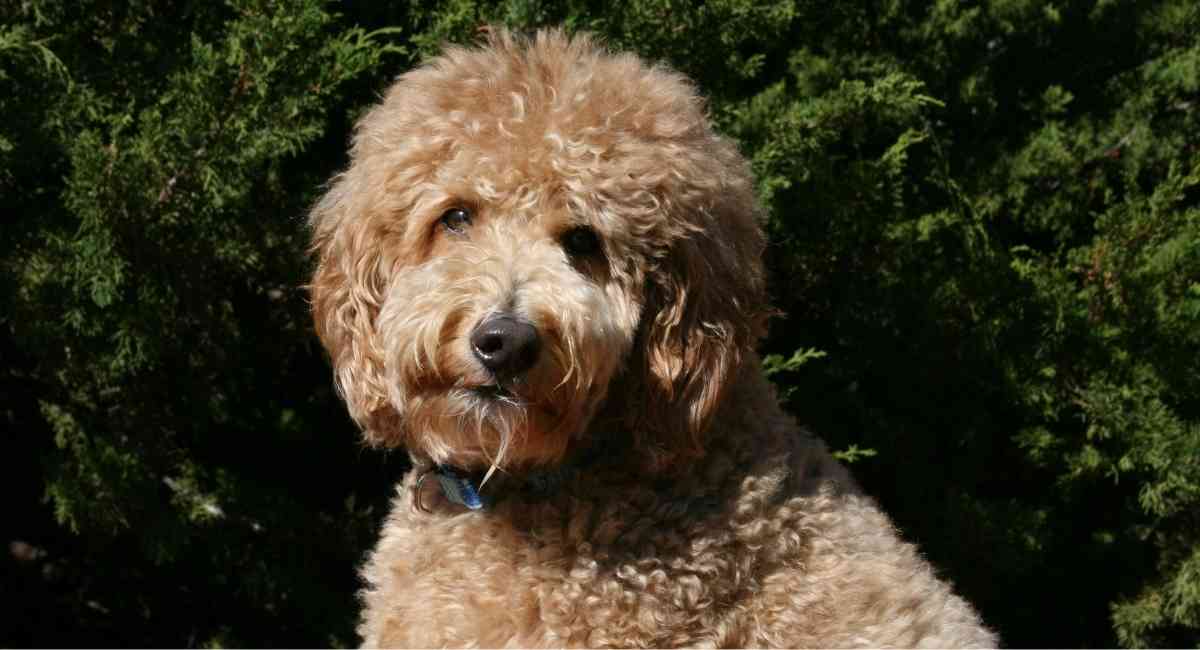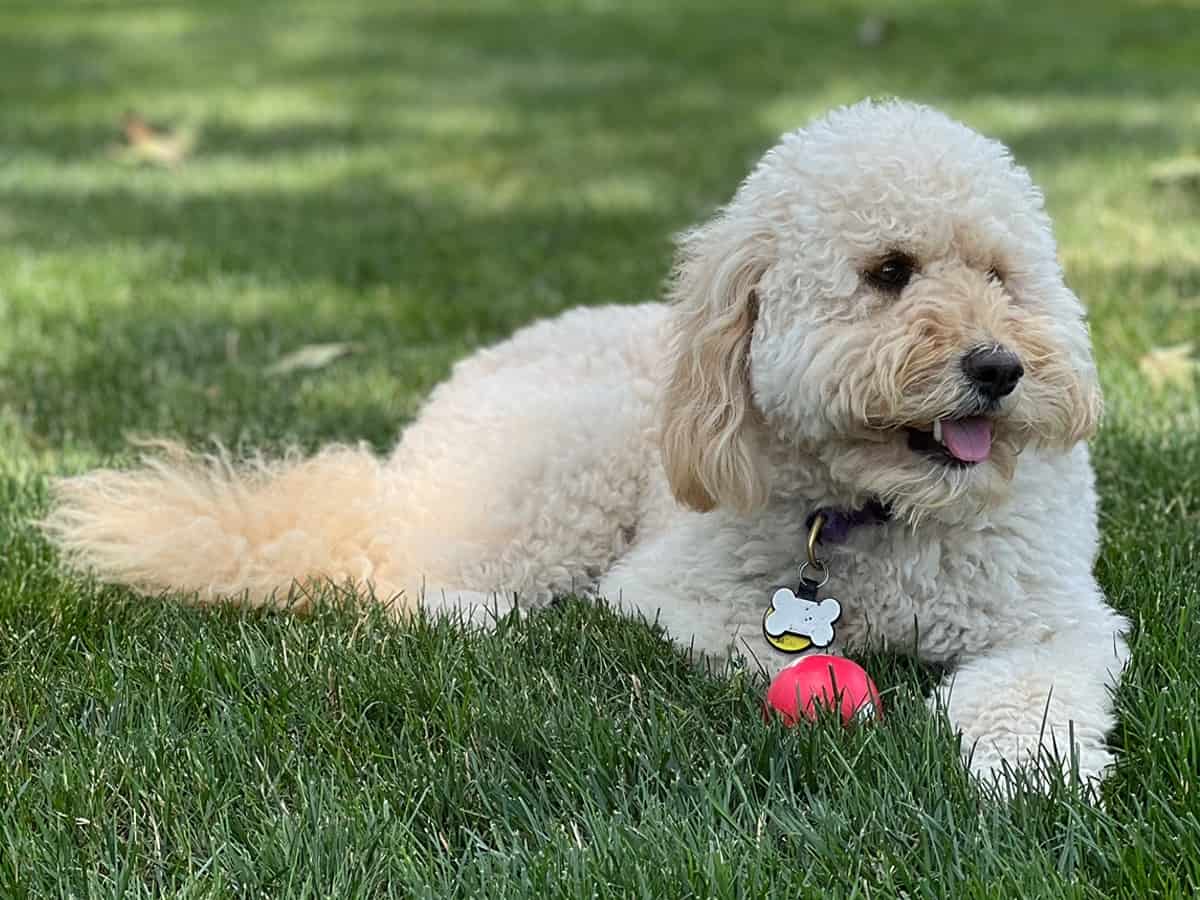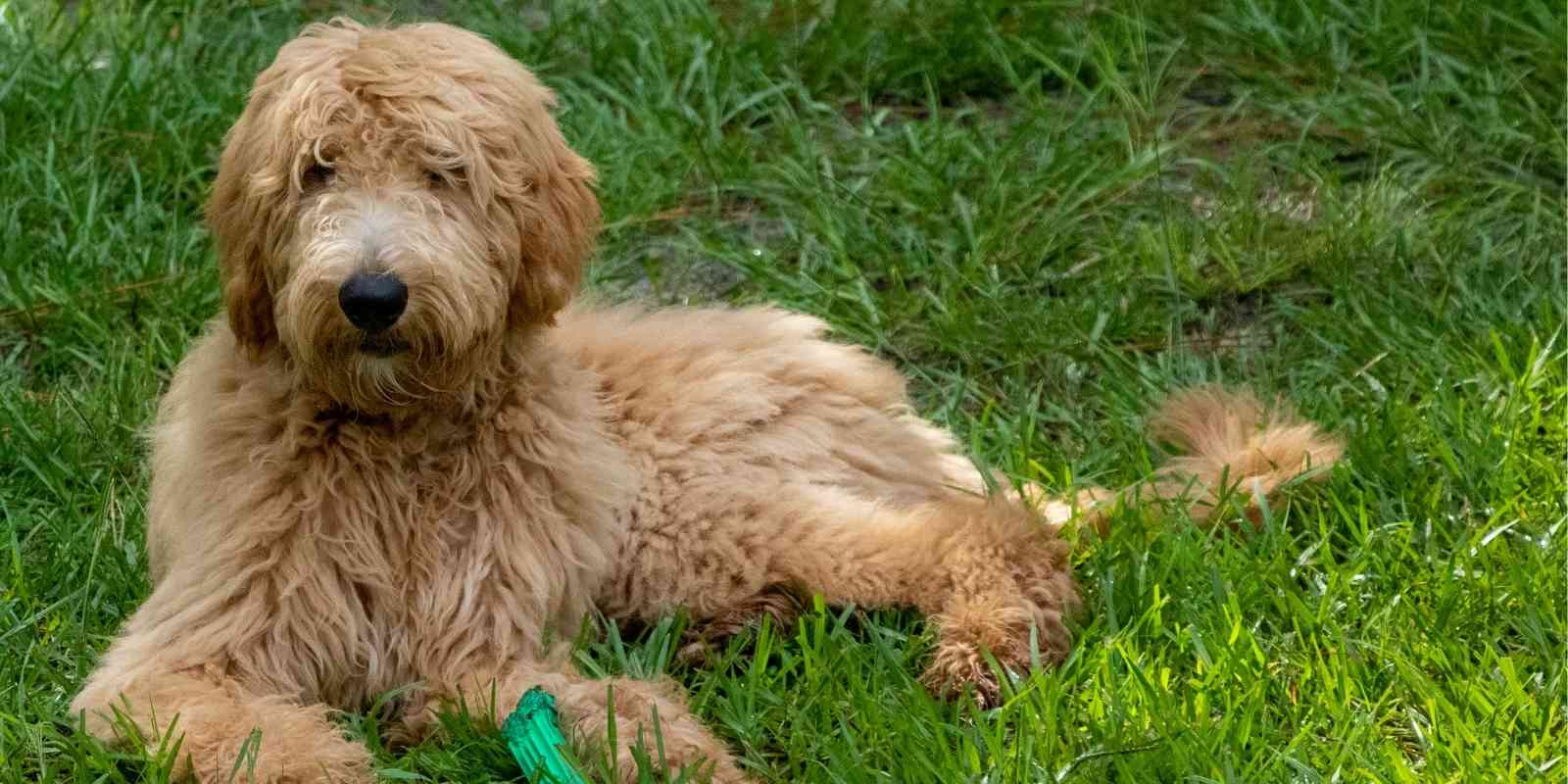If you’re in the market for a Goldendoodle, you almost certainly know that they are a mix between a Poodle and a Golden Retriever. What may be less clear is the meaning of the various letter-and-number combinations (e.g., f1, f2, f1b, f2b, etc) that breeders apply to different types of Goldendoodles. Take, for example, an F1B vs. F2B Goldendoodle. While both are Goldendoodles, the F1B has a Goldendoodle parent and a Poodle parent (with its breed mix being 25% Golden Retriever and 75% Poodle) and the F2B has two Goldendoodle parents (with its breed mix being 37.5% Golden Retriever and 62.5% Poodle).
Below, we’ll explain in more detail what makes an F1B Goldendoodle different from an F2B Goldendoodles, including the practical implications. In the meantime, its important to keep in mind that the characteristics of Goldendoodles can vary greatly depending on these two factors: (1) how many generations removed the offspring are from the initial Poodle x Golden Retriever crossbreeding; and (2) the approximate percentage of Poodle and of Golden Retriever in the Goldendoodle offspring.
What Is a Goldendoodle?
We’ve all probably been hearing a lot about Goldendoodles because they are one of the top dogs on the market currently. However, we’ve realized that many of us just know the name and what they look like but don’t understand the true development.
We will use this section to break down what Goldendoodles are before discussing the different generations.
When we say Goldendoodle, it is a special breed that doesn’t come naturally or as a purebred. Instead, Goldendoodles are created from the cross between a purebred parent breed and another purebred parent breed with a different trait.
In the case of the Goldendoodle, the parents involved are the Golden Retriever and Poodle. The crossbreeding of the Golden Retriever and the Poodle is how breeders created the first-generation Goldendoodles.
Subsequent crossing and backcrossing of the first generation Goldendoodle further lead to more generations with diverse traits. And these new generations are differentiated by putting the generation name before the breed name, as seen in F1 Goldendoodle, F1B Goldendoodle, F2B Goldendoodle, etc.
We want to focus on the main generations, the F1B Goldendoodle, and the F2B Goldendoodle. However, to better explain them, we will take you through the initial generations that lead us here.
Later in the article, you’ll also see the differences between the F1B Goldendoodle and the F2B Goldendoodle. We’ll do an F1B vs F2B Goldendoodle comparison for those that have been asking.
Basic Generations of Goldendoodles
The generations we will be discussing now are the foundations on which the rest of the generations are built.
The First Filial Generation – F1 Goldendoodle
The F1 Goldendoodles are the first hybrids produced, and they are bred from the cross of two purebred parents. Purebred parents occur naturally in nature, and their genetic composition is 100%.
In the case of the Goldendoodle, the purebred parents involved are the Golden Retriever and Poodle.
In genetic crossing, the parents are specially selected because of certain traits they possess and wish to pass down to the hybrid. Crossbreeding is also carried out to eliminate some genetic disorders and produce a healthier mixed breed.
The Golden Retriever is a smart dog with good genes, and it is susceptible to a few illnesses. However, the coat of the Golden Retriever is straight, and it allows shed skin to get fall. Shed skin in dogs is a big deal because it has dander, and dander is what makes people have allergic reactions to their dogs.
A cross is done with the Poodle to eliminate the allergic nature of the Golden Retriever and obtain a more hypoallergenic pet. The Poodle is an exotic dog, and many people keep them as in-house pets.
Poodles don’t cause allergic reactions except in rare cases, and this is why they are commonly used as in-house pets. The hypoallergenic trait of the Poodle is thanks to its wavy or curly coat.
Let us quickly explain how the coat affects the hypoallergenic trait of the dog.
When your dog sheds, there is a protein in the shedding called dander, and when humans are exposed to dander, it causes severe allergic reactions. For a dog like the Golden Retriever with a straight coat, shed skin falls out, and you can easily come in contact with it. However, the Poodle has a wavy or curly coat that traps the dander, rarely causing an allergic reaction.
The point of this explanation is to help you understand why the Poodle was chosen to be crossed with the Golden Retriever. It was completely intentional. The cross aims to produce a dog with the personality traits of the Golden Retriever and the hypoallergenic trait of the Poodle.

First Filial Generation with a Backcross – F1B Goldendoodle
What differentiates this generation from the F1 Goldendoodle is the parent involved. The term backcross means crossing a hybrid from the first filial generation with one of the purebred parents.
The F1B Goldendoodle is created by crossing an F1 Goldendoodle with a 100% Poodle. The Poodle is used for the backcross because it is the one with that trait that we want to manifest in the offspring.
The F1 Goldendoodle has a composition of 50% Golden Retriever and 50% Poodle, but doing a backcross changes the genetic composition of the doodle to 75% Poodle and 25% Golden Retriever.
The variation in the genetic composition has an obvious effect on the F1B Goldendoodle, and we can see the difference in the physical appearance and hypoallergenic trait.
We’ll come back to talk more about the F1B Goldendoodle.
Second Filial Generation – F2 Goldendoodle
The second filial generation or F2 generation is obtained from crossing the parents from the first filial generation. The F2 Goldendoodle is made by breeding two F1 Goldendoodles.
There isn’t much difference between the F1 Goldendoodles and the F2 Goldendoodles – they have the same genetic differentiation, 50% Golden Retriever and 50% Poodle. You will likely see more diversity in the F2 Goldendoodles than the F1B Goldendoodles.
F2 Goldendoodles still show signs of Golden Retrievers – most have straight short hair that sheds. There is still a high chance of them triggering allergic reactions in people with severe allergies.
Second Filial Generation with a Backcross – F2B Goldendoodle
We already mentioned that the backcross is achieved when a hybrid is bred with one of the purebred parent breeds. The F2B Goldendoodle is a multi-generational Poodle formed from the cross between an F2 Goldendoodle and a purebred Poodle.
The backcross aims to produce a generation with more traits like the purebred Poodle. It is easier to determine the qualities you want in your Goldendoodle because the dog will take the larger percentage of the Poodle’s traits.
Depending on the crossing, the F2B doodle can be 62.5% Poodle and 37.5% Golden Retriever, or 75% Poodle and 25% Golden Retriever.
Now that you understand the concept of the Goldendoodle generations, we want to focus on the F1B and F2B Goldendoodles.
F1B Goldendoodle
The F1B Goldendoodle is bred by crossing the F1 Goldendoodle with the purebred Poodle. It is expected that the doodle will inherit some traits from both parents, and we see these traits in the dog’s physical appearance and physiological performance.
Let’s take a look at some of their traits.
Characteristics
Energetic
The parent breeds involved in making the Goldendoodle are very energetic dogs. It is not a surprise that the F1B doodles also inherit this energetic trait.
It is rare for your F1B Goldendoodle pup to stay calm for a long time – if they are, it can be a sign that your dog is sick. F1B doodles are great for the kids because they have the energy and can keep up with them.
F1B Goldendoodles also have a lot of stamina, making for wonderful exercise companions. Unlike the mini Goldendoodle, the F1B Goldendoodle can keep up with you over long distances. You don’t have to worry about your dog getting tired or fatigued before returning home.
Intelligent
Anybody that owns an F1B Goldendoodle will tell you that these dogs are very smart. Most times, the F1B Goldendoodle will exhibit a level of intelligence that is very close to being human. They are easy to train and always open to challenges.
F1B Goldendoodles need to be occupied most of the time. They are always looking for things to do. Their sharpness is another reason they are great for families with kids because they are always ready to play. Getting a Goldendoodle is also an effective way to keep both the kids and the dog busy without stressing yourself out.
Protective
We’ve noticed that the F1B Goldendoodle is very protective and observant. You can count on the Goldendoodle to come to your defense at the slightest sign of danger or discomfort.
Don’t be fooled by their cheerful and cute appearances, your F1B Goldendoodle will switch into guard dog mode if it senses that you’re in danger.
Low Shedding
Let me use this opportunity to clear a common misconception. All dogs shed, and it is a mistake to think that there are breeds that don’t.
It is more accurate to say that some dogs shed less than others, just like the Poodle sheds less than the Golden Retriever.
The genetic cross that constitutes the F1B Goldendoodle affects the shedding. The F1B Goldendoodle shows a significant reduction in the shedding compared to the purebred Golden Retriever and the F1 Goldendoodle.
The reduced shedding is because of the backcross done with 100% Poodle, and the F1B Goldendoodle has more Poodle traits. Don’t interpret this to mean your dog won’t shed at all.
You will need to groom the wavy coat of your F1B Goldendoodle regularly, which could be every 2 to 3 weeks.

F2B Goldendoodle
As we’ve said before, the F2B Goldendoodle is made by crossing an F2 Goldendoodle with a purebred Poodle. However, there is another way to get F2B Goldendoodles, and that is by crossing an F1B Goldendoodle with an F1 Goldendoodle.
Doing the latter will give you an F2B Goldendoodle 62.5% Poodle and 37.5% Golden Retriever.
Characteristics
Size
As a result of the backcrossing with a purebred Poodle, it is possible to get different sizes of F2B Goldendoodles.
The size of the doodle will depend on the size of the Poodle used in the backcross. It could be a toy, small, medium, or standard F2B Goldendoodle.
This is one of the advantages of backcrossing – it limits the extent of variability and allows for developing more specific traits.
Energy
The F2B Goldendoodles are very energetic, and they love being all over the place. However, the stamina of your dog will be dependent on the size.
Larger breeds of the F2B Goldendoodles have more stamina and can play for a long time before taking a break. However, breeds like the toy F2B Goldendoodle run out of juice after a few hours of running around and will prefer to rest beside you.
Intelligent
The F2B Goldendoodles are also very smart since both parents involved in their crossing are witty. They are easy to train and are often used as service dogs or emotional support dogs.
The F1B vs F2B Goldendoodle: Main Differences
The F1B and F2B Goldendoodle are pretty similar, but let’s look at some of the main differences:
Health
One of the advantages of crossbreeding is the elimination of genetic defects that cause health problems. Mixed breeds, such as the Goldendoodle have hybrid vigor, meaning genetic defects in the purebred parents tend not to be passed down to the offspring unless both parents have that defect.
The hybrid vigor in the F1B Goldendoodle is higher than that of the F2B Goldendoodle. The F2B Goldendoodle undergoes more crossing further down the generation. So it is more likely to inherit more genetic disorders.
Overall, Goldendoodles are relatively healthy dogs with strong immunity. However, they still contract some serious diseases, such as hypothyroidism and Addison’s disease, which will impact their life expectancy.
Shedding
The F1B Goldendoodle is 75% Poodle and 25% Golden Retriever, while the F2B Goldendoodle can either be 75% Poodle and 25% Golden Retriever or 62.5% Poodle and 32.5% Golden Retriever.
Both breeds shed less than the average Goldendoodle, but there is a higher probability of the F2B Goldendoodle shedding a bit more.
Are They Really That Different?
The F1B Goldendoodle and F2B Goldendoodle have been bred to produce cute dogs with some of the best traits of the Golden Retriever and the Poodle. It can be challenging deciding which of the two varieties is best for you since their differences are subtle.
We’ve gone over the main differences between the F1B vs F2B Goldendoodle, on average the F1B can be slightly healthier and may shed a bit less than the F2B. Either way, both Goldendoodle varieties are great pets to have, and are suitable for people with allergies.

